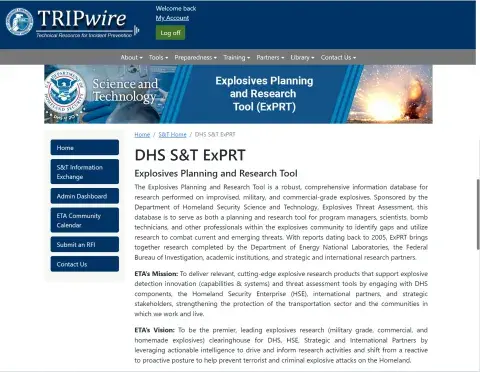
Every second counts when responders encounter an explosive device, and critical decisions must be made quickly in order to neutralize the threat while also ensuring the security of civilians, property, and the responders themselves. Knowledge is power, as they say, and the Science and Technology Directorate (S&T) will soon roll out a state-of-the-art database that will give the Department of Homeland Security (DHS) subject matter experts (SMEs) and frontline personnel access to information that is essential to mission success. ExPRT will provide SMEs, first responders, and members of the explosives research community with quick and easy access to relevant scientific and research, development, test, and evaluation data spanning from the early 2000’s to present.

“Over the past 20 years, DHS and its partners have invested more than $60 million in basic and applied research that has resulted in critical findings and the development of groundbreaking tools and technologies that have helped to prevent or mitigate countless explosive threats,” said S&T’s Explosives Threat Assessment (ETA) Program Manager Dr. Anna Tedeschi. “However, as we look to the future of this field, we’ve run into a new challenge: finding a way to effectively organize, compile, and share this information to ensure ongoing collaboration, avoid conducting repetitive or unnecessary studies, prevent institutional memory loss, and to strategically plan and budget program investments in future research to close knowledge or technology gaps.”
To address this unique challenge, Dr. Tedeschi and SMEs from S&T’s Modeling and Simulation Technology Center (MS-TC) performed a series of evaluations to derive a solution that would accomplish this goal and at the same time facilitate new conversations about how to best address potential explosives threats as we look to the future. After determining a best path forward to share this vital information, ETA and MS-TC SMEs approached the Cybersecurity and Infrastructure Security Agency’s Office for Bombing Prevention (OBP) to collaborate on the opportunity. OBP was immediately interested, proposing the Technical Resource for Incident Prevention (TRIPWire) Portal as a platform for developing, prototyping and hosting ExPRT to ensure it remains a secure, web-based one-stop-shop for the explosives research community.
“ExPRT provides critical explosives research to our SMEs who need it the most,” explained Dr. Tedeschi. “Once implemented it will vastly improve our collaborative efforts to continue protecting the nation from any future explosive threats, and also serve as a resource for ensuring best practices.”
ExPRT’s landing page summarizes ETA’s mission and describes the database. It also provides a ‘contact us’ widget for SMEs who want to request access and includes a calendar of events so that they can network with each other.
Database users have access to a comprehensive research library that includes both completed and ongoing studies, technical information like explosives characterization, reports related to existing screening and mitigation technologies, and contact information for organizations that have funded and conducted relevant studies. Users will also be able to upload their own materials and provide feedback to the ExPRT team, who will use this feedback to improve the functionality and content of both the website and database as needed.
“ExPRT is a versatile research platform that can help DHS and the explosives community meet their immediate and long-term needs,” said Dr. Tedeschi. “For example, if an intelligence analyst identifies a bomb threat in the field, we want them to be able to contact SMEs who can then immediately query ExPRT and determine whether it is a known or new threat and provide guidance to our responders in the field. The database will also be accessible from mobile devices via a mobile-friendly website or application so that responders can access it themselves if they feel comfortable doing so.”
“We recognize that we are in a field that is rapidly evolving and changing,” continued Dr. Tedeschi. “Our priority in the near future will be to expand the database by adding content in the areas of explosives detection by canines, as well as relevant research conducted by our university and international partners.”
This spring, the ExPRT development team released a minimum viable product for both the landing page and database. “We are conducting internal user and usability testing on a limited version of ExPRT, to ensure that its basic features are working as intended,” explained Dr. Tedeschi. “This testing also provides a valuable opportunity to continuously evaluate ExPRT to determine what design, function and information gaps need to be addressed, and provide inspiration and insights to extend its capabilities further via future updated production releases.”
Once internal testing is completed, the team will work closely with colleagues at the Department of Energy (DOE) laboratories and the Federal Bureau of Investigation (FBI) as they independently assess ExPRT and perform functional use-case and other tests to validate how well it will work in the field.
“We will ask them to assess the overall layout, ease of navigation and use, functionality, and overall accuracy and relevance of the information provided,” said Dr. Tedeschi. “Their feedback will then be used to improve future iterations of the capability, once ExPRT goes live.”
“The SMEs at the DOE labs and FBI have a very crucial role in the development process for ExPRT,” continued Dr. Tedeschi. “They are representative of the organizations, partners, and people who will utilize this resource in the field, so we need to ensure that everything is easy to use and functional for them.”
The S&T ETA team plans to do an iterative rollout of the website and database this fall and will continue to expand upon and improve ExPRT based on continual feedback from the explosives research community.

